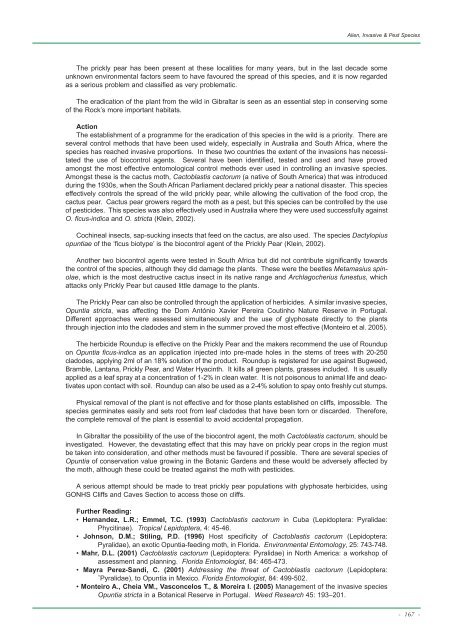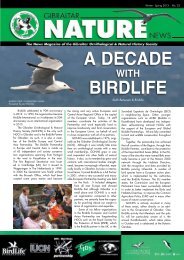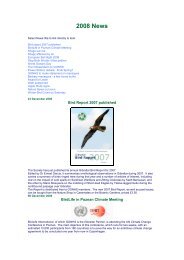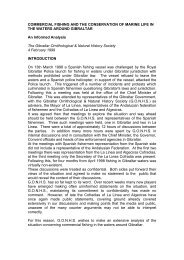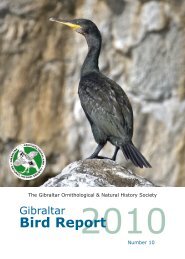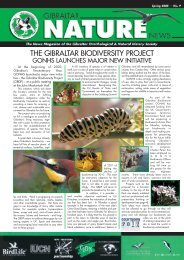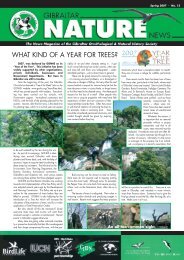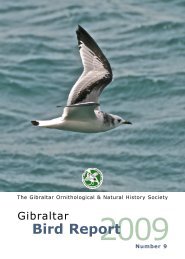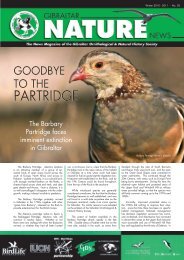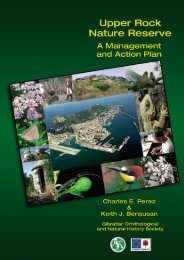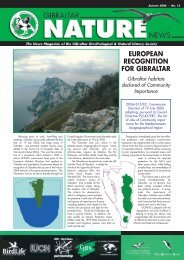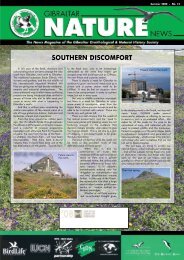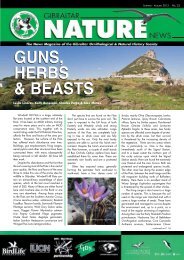Available as a PDF download - Gibraltar Ornithological & Natural ...
Available as a PDF download - Gibraltar Ornithological & Natural ...
Available as a PDF download - Gibraltar Ornithological & Natural ...
Create successful ePaper yourself
Turn your PDF publications into a flip-book with our unique Google optimized e-Paper software.
Alien, Inv<strong>as</strong>ive & Pest Species<br />
The prickly pear h<strong>as</strong> been present at these localities for many years, but in the l<strong>as</strong>t decade some<br />
unknown environmental factors seem to have favoured the spread of this species, and it is now regarded<br />
<strong>as</strong> a serious problem and cl<strong>as</strong>sified <strong>as</strong> very problematic.<br />
The eradication of the plant from the wild in <strong>Gibraltar</strong> is seen <strong>as</strong> an essential step in conserving some<br />
of the Rock’s more important habitats.<br />
Action<br />
The establishment of a programme for the eradication of this species in the wild is a priority. There are<br />
several control methods that have been used widely, especially in Australia and South Africa, where the<br />
species h<strong>as</strong> reached inv<strong>as</strong>ive proportions. In these two countries the extent of the inv<strong>as</strong>ions h<strong>as</strong> necessitated<br />
the use of biocontrol agents. Several have been identified, tested and used and have proved<br />
amongst the most effective entomological control methods ever used in controlling an inv<strong>as</strong>ive species.<br />
Amongst these is the cactus moth, Cactobl<strong>as</strong>tis cactorum (a native of South America) that w<strong>as</strong> introduced<br />
during the 1930s, when the South African Parliament declared prickly pear a national dis<strong>as</strong>ter. This species<br />
effectively controls the spread of the wild prickly pear, while allowing the cultivation of the food crop, the<br />
cactus pear. Cactus pear growers regard the moth <strong>as</strong> a pest, but this species can be controlled by the use<br />
of pesticides. This species w<strong>as</strong> also effectively used in Australia where they were used successfully against<br />
O. ficus-indica and O. stricta (Klein, 2002).<br />
Cochineal insects, sap-sucking insects that feed on the cactus, are also used. The species Dactylopius<br />
opuntiae of the ‘ficus biotype’ is the biocontrol agent of the Prickly Pear (Klein, 2002).<br />
Another two biocontrol agents were tested in South Africa but did not contribute significantly towards<br />
the control of the species, although they did damage the plants. These were the beetles Metam<strong>as</strong>ius spinolae,<br />
which is the most destructive cactus insect in its native range and Archlagocherius funestus, which<br />
attacks only Prickly Pear but caused little damage to the plants.<br />
The Prickly Pear can also be controlled through the application of herbicides. A similar inv<strong>as</strong>ive species,<br />
Opuntia stricta, w<strong>as</strong> affecting the Dom António Xavier Pereira Coutinho Nature Reserve in Portugal.<br />
Different approaches were <strong>as</strong>sessed simultaneously and the use of glyphosate directly to the plants<br />
through injection into the cladodes and stem in the summer proved the most effective (Monteiro et al. 2005).<br />
The herbicide Roundup is effective on the Prickly Pear and the makers recommend the use of Roundup<br />
on Opuntia ficus-indica <strong>as</strong> an application injected into pre-made holes in the stems of trees with 20-250<br />
cladodes, applying 2ml of an 18% solution of the product. Roundup is registered for use against Bugweed,<br />
Bramble, Lantana, Prickly Pear, and Water Hyacinth. It kills all green plants, gr<strong>as</strong>ses included. It is usually<br />
applied <strong>as</strong> a leaf spray at a concentration of 1-2% in clean water. It is not poisonous to animal life and deactivates<br />
upon contact with soil. Roundup can also be used <strong>as</strong> a 2-4% solution to spay onto freshly cut stumps.<br />
Physical removal of the plant is not effective and for those plants established on cliffs, impossible. The<br />
species germinates e<strong>as</strong>ily and sets root from leaf cladodes that have been torn or discarded. Therefore,<br />
the complete removal of the plant is essential to avoid accidental propagation.<br />
In <strong>Gibraltar</strong> the possibility of the use of the biocontrol agent, the moth Cactobl<strong>as</strong>tis cactorum, should be<br />
investigated. However, the dev<strong>as</strong>tating effect that this may have on prickly pear crops in the region must<br />
be taken into consideration, and other methods must be favoured if possible. There are several species of<br />
Opuntia of conservation value growing in the Botanic Gardens and these would be adversely affected by<br />
the moth, although these could be treated against the moth with pesticides.<br />
A serious attempt should be made to treat prickly pear populations with glyphosate herbicides, using<br />
GONHS Cliffs and Caves Section to access those on cliffs.<br />
Further Reading:<br />
• Hernandez, L.R.; Emmel, T.C. (1993) Cactobl<strong>as</strong>tis cactorum in Cuba (Lepidoptera: Pyralidae:<br />
Phycitinae). Tropical Lepidoptera, 4: 45-46.<br />
• Johnson, D.M.; Stiling, P.D. (1996) Host specificity of Cactobl<strong>as</strong>tis cactorum (Lepidoptera:<br />
Pyralidae), an exotic Opuntia-feeding moth, in Florida. Environmental Entomology, 25: 743-748.<br />
• Mahr, D.L. (2001) Cactobl<strong>as</strong>tis cactorum (Lepidoptera: Pyralidae) in North America: a workshop of<br />
<strong>as</strong>sessment and planning. Florida Entomologist, 84: 465-473.<br />
• Mayra Perez-Sandi, C. (2001) Addressing the threat of Cactobl<strong>as</strong>tis cactorum (Lepidoptera:<br />
¨Pyralidae), to Opuntia in Mexico. Florida Entomologist, 84: 499-502.<br />
• Monteiro A., Cheia VM., V<strong>as</strong>concelos T., & Moreira I. (2005) Management of the inv<strong>as</strong>ive species<br />
Opuntia stricta in a Botanical Reserve in Portugal. Weed Research 45: 193–201.<br />
- 167 -


